Introduction: In this blog article, Gena Philibert-Ortega searches old newspapers to learn about the history of Memorial Day. Gena is a genealogist and author of the book “From the Family Kitchen.”
The last Monday in May is considered by many to be the start of the summer season. You may be looking forward to a much-needed three-day weekend, and dreaming of warmer weather, swimming and picnics to come. But of course, the last Monday in May also has an official and very serious significance: it is Memorial Day.
Do you know the history of Memorial Day? Most people realize that Memorial Day has to do with remembering those in the military – but there are actually three days in which we honor those in the military, each day for a specific group:
- Armed Forces Day honors current members of the military. This day, observed on the third Saturday in May, is a great time to thank those currently serving in the military.
- Veterans Day, on November 11, is rooted in World War I and Armistice Day and honors our veterans.
- Memorial Day, first observed shortly after the Civil War, honors those who have died in service to their country.
All three observances have changed over time, and the history of Memorial Day includes a name change – it was once called Decoration Day.
Decoration Day
While there are many different stories about the origins of Decoration Day, the U.S. Department of Veterans Affairs’ Office of Public Affairs reports that:
Three years after the Civil War ended, on May 5, 1868, the head of an organization of Union veterans – the Grand Army of the Republic (GAR) – established Decoration Day as a time for the nation to decorate the graves of the war dead with flowers.*
Prior to 1868 there were groups all over the United States holding events to honor their war dead. Women in the Southern states were decorating the graves of their fallen and honoring them as early as 1866. This 1922 Oklahoma newspaper article honors some of those women and their very earliest observances of Decoration Day.
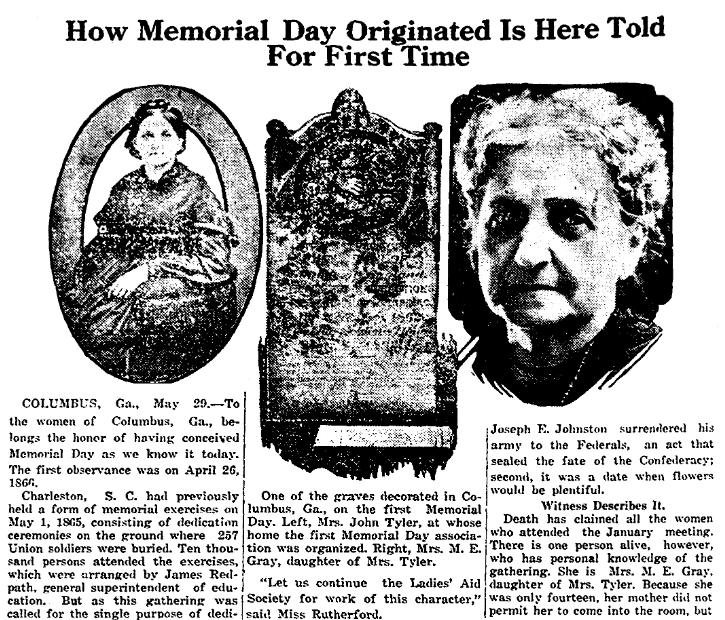
This newspaper article ends by mentioning that not every state observed Memorial Day in May, and that the American Legion was urging the United States, and the world, to hold a yearly universal observance on May 30th.
This 1869 New Hampshire newspaper article reminds readers that the upcoming Decoration Day observance was the first anniversary of the day of remembrance:
…set apart and forever to be observed for decorating with flowers and tokens of remembrance the hallowed graves of those who perished in the latest desperate struggle to save the life of the nation when assailed by its enemies and the foes of equal rights to all men.
It goes on to remind readers of the importance of remembering those soldiers:
It is right and proper that all of us should be reminded that we are enjoying the blessings of a government which these sleeping heroes fought for and maintained, and in no way can we be so forcibly and impressively reminded of it as by the beautiful ceremonies which will henceforth mark the anniversary of Decoration Day.
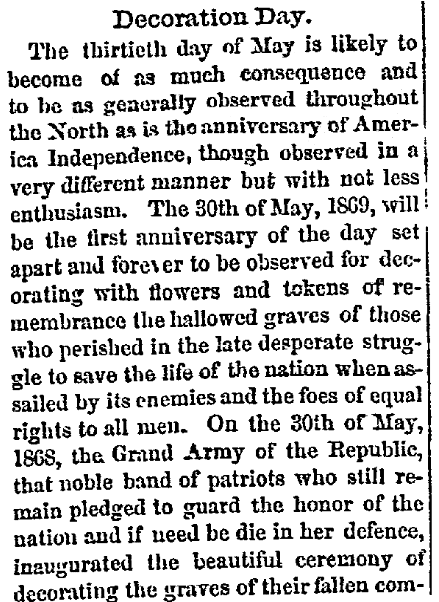
Like Memorial Day today, early Decoration Day ceremonies included the decorating of graves as well as speeches and music. Decoration Day in Brooklyn, New York, in 1869 included the reading of Lincoln’s Gettysburg Address and music. An impressive 3,500 graves were decorated that day.
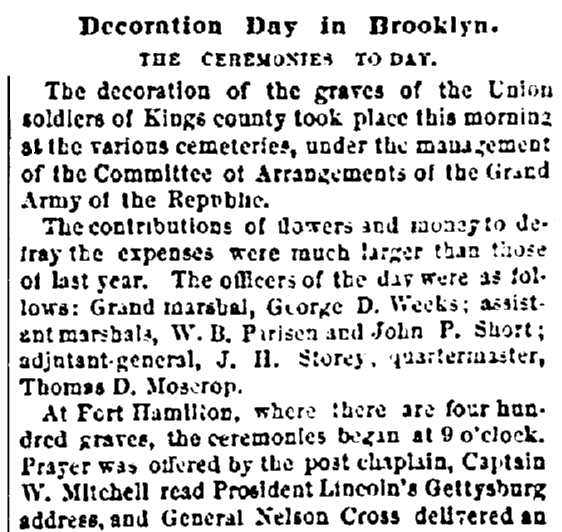
A Day to Remember and Honor
Communities across the United States had – and have – their own ways to honor their war dead on Decoration Day/Memorial Day. Patriotic concerts, speeches, and events held at national and local cemeteries are planned.
In 1922 Decoration Day included the dedication of the Lincoln Memorial in Washington, D.C. President Abraham Lincoln had been killed days before the end of the Civil War. A struggle that weighed heavily on him, the Civil War pitted families against each other, and affected every American. It seems fitting that on a day when the Gettysburg Address was routinely recited to honor the Civil War dead, the Lincoln Memorial in Washington, D.C., was dedicated on Decoration Day.
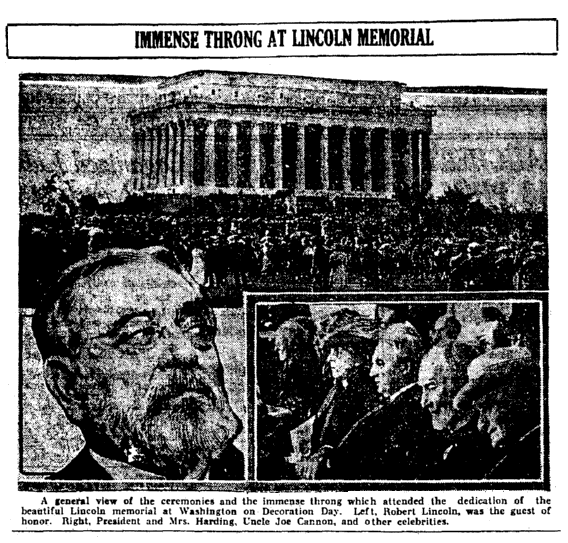
Lincoln’s memory was honored by those in attendance that Decoration Day, which included such dignitaries as former, current, and future Presidents Taft, Harding and Coolidge, presidential daughter Alice Roosevelt Longworth, and Abraham Lincoln’s son Robert Todd Lincoln.
You can watch a soundless video of the actual 1922 ceremony courtesy of the National Archives: https://www.youtube.com/watch?v=DVUbzOk8mCc
Memorial Day
The change in name from Decoration Day to Memorial Day was gradual from the late 19th century into the 20th century. A search through GenealogyBank’s Historical Newspaper Archives shows that either term was used in newspaper articles throughout this period. But as the holiday went from strictly honoring the Civil War dead to including those who died in all subsequent wars, “Memorial Day” became the preferred term, and was made official by federal law in 1967. Also that year, a bill was introduced to make four federal holidays – including Memorial Day – fall on Mondays to give workers a three-day weekend.
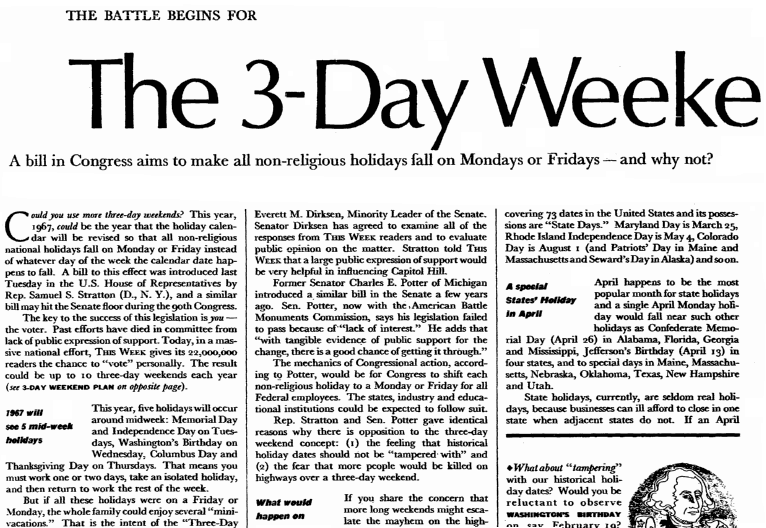
Passage of the Uniform Monday Holiday Act in 1968 assigned Memorial Day to the last Monday in May, abandoning the traditional May 30 date (although this year, Memorial Day happens to be May 30).
Your Memorial Day Weekend
Whether you are spending this weekend honoring your family who died in battle – or helping others remember by placing flags on graves or taking part in a community observance – I hope your day is meaningful.
————————–
* Memorial Day History. U.S. Department of Veterans Affairs. Office of Public Affairs.
